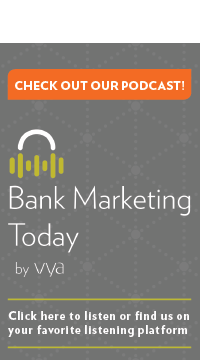 Through our Bank Marketing Today podcast, I’ve had the distinct pleasure of speaking with a number of successful financial marketing executives who have taught me and our listeners a great deal about successful marketing strategies for banking products.
Through our Bank Marketing Today podcast, I’ve had the distinct pleasure of speaking with a number of successful financial marketing executives who have taught me and our listeners a great deal about successful marketing strategies for banking products.
Reflecting on these conversations, one thing that stands out to me is that, despite the wide range of financial services these bank marketers represent, and the distinctions between consumer and business banking products, there are fundamental bank marketing strategies that are common across successful financial institutions.
Among these common strategies is the importance of building trust, the need for a seamless omni-channel customer experience, the power of the story in marketing communications, and a commitment to data-driven marketing. These bank marketing executives also share a passionate focus on the customers and the local communities their banks serve.
The Importance of Building Trust
Building trust with customers is one of the foundational strategies shared by successful financial services marketers. In one of our podcast discussions focused on CX, Academy Bank Director of Marketing and Client Experience Officer Charles Freeman talked about building trust through the lens of customer experience.
His focus on CX gives him a daily insight into the changing needs of the financial institution’s customers. He strongly believes that if you’re talking with and listening to customers every day, that can’t help but improve your bank marketing. And it’s critical to building their trust.
Freeman pointed to USAA as an example of a financial institution that has developed a high level of trust with its members by being supremely responsive to customer needs. “They [USAA] are, at their very core, responsive,” he said. “It’s a part of a trust they have won. And that’s how they develop that emotional connection with their clients. And it’s enviable.”
But how do you build that trust and that emotional connection? According to Sean Hampton, Chief Marketing Officer at BOK Financial, it’s all about relationships. Businesses are still run by people and financial services are consumed by people. So, it’s important to make sure your customers feel like their relationship with you is very unique and individualized, even if you’re dealing with a commoditized group of financial services product offerings that don’t offer any real differentiation.
He explains, “You really spend the time and effort in that partnership relationship that leads the client and the prospect into your products. And, then they start looking at your products in a differentiated way, as opposed to just the same products they could have gotten at any of our competitors.”
And, it’s often those on the frontlines of your organization who make the difference.
Hampton says, “A lot of it comes from a handshake between one individual within our company and another individual, because they trust each other.”
One employee might have a Treasury Services customer and recognizes an opportunity to introduce this customer to a colleague on the institutional wealth side of the organization. Hampton explains, “The relationship that is built between those two individuals is so synonymous and it’s so synchronous that the client sees us as one company and not as two completely different sections within the same company. Relationships start there.”
The Need for a Seamless Omni-Channel Customer Experience
We’re seeing more and more banking executives having responsibility for both marketing and the customer experience. This is likely because there needs to be a continuous, seamless customer journey, from acquiring potential customers to onboarding to servicing.
Sometimes there are CX expectations placed on the marketing organization without really having the responsibility to impact it. That puts those marketers in a tough spot. Having the opportunity to lead both functional areas can put a marketing team in a better position to be able to deliver on the brand promise.
Academy Bank’s Freeman said of his blended marketing and CX role, “It has made a tremendous difference in how I approach my job and how I look at our clients. And I think there’s a number of ways that if you look at this, and how it really integrates well, and how we’re able to get better by marrying those two disciplines.”
Dorian Hansen, Chief Marketing Officer and Head of Operations and Digital Transformation at Investors Bank, brings a customer-centric approach to her marketing, operations and digital transformation roles. She has a saying, “Who cares what we think. It’s what the customer thinks.”
Hansen’s team knows how customers are interacting with the financial institution and they’re measuring the overall satisfaction of every interaction, regardless of the channel – ATM machine, branch, mobile app or online banking via desktop.
She and her team assumed responsibility of the Investors Bank call center, which handles 500,000 customer support calls a year, and which she sees as an important channel – the face of the financial institution in many cases. “We said, you know, we think there are things that we can do to transform our call center and really, really, really focus on how we deliver an outstanding experience when somebody calls us, because that is a channel.”
In talking about her digital transformation efforts, Hansen told us about an ah-ha moment when the organization recognized that while it had done incredible work in digitally transforming customer-facing systems and processes, back-of-the-house operations needed to catch up to support the bank it is now, not the bank it used to be. For those in support roles, it was actually harder for them to do their job in supporting all the change that was occurring in the front of the house. So, the digital transformation focus turned to the back office.
For financial services marketers, supporting an omni-channel customer experience requires having a marketing resource management system to house all of your cross-channel communication materials and ensure consistent messaging across digital media, print, and in-person interactions. These systems can also have bank-wide impact – for example, by housing customizable recruiting, onboarding and training assets for HR, or integrating budget management and spend tracking that reduces the number of invoices sent to Accounts Payable. Marketing resource management systems can also help reduce the time and attention focused on mundane tasks, freeing up staff for more strategic efforts.
“If someone internally is having difficulty doing their job, that will telegraph out to a customer,” adds Hansen. “If it’s not easy for us to do our job to support the customer, then it won’t be easy for the customer to do business with us. There’s a lot of opportunity here to transform the way people that support the front of the house are doing their job. To do it faster, better, and having them focusing on things that are more impactful than doing some repetitive tasks that I can automate.”
The Power of Story and Video-Based Communication
Another common strategy shared by successful financial services marketers is powerful story telling. Laura Sullivan Etheridge, EVP and Chief Marketing Officer at Hancock Whitney, confirmed in her discussion with us, “One of the roles of marketing is to ensure we are intentionally telling our stories.”
She explained there are certain communications activities she uses to tell Hancock Whitney’s stories. The use of YouTube and short-term, more casual videos and storytelling have been powerful digital marketing tools in helping get stories out. She says costly high-end film production is not necessary when the stories are compelling and focused on the people the financial institution serves.
Her team has created a video platform called Project Hometown that shares stories derived from the bank’s “Plan Your Way Home” first-time home-buyers program. The bank has also used video stories to demonstrate how it shows up in the communities it serves. One story focused on how the bank had boots on the ground in Gulfport, Louisiana following Hurricane Zeta. Etheridge’s team produced other video stories about the bank’s PPP support for local businesses impacted by the pandemic.
“We try to bring to life the stories of what we’re already doing,” said Etheridge.
Whether it’s with video or some other medium, Eric Giesecke, CMO of WesBanco stresses it’s simply important to proactively tell your story.
He told us, “You can have a physical presence and potentially have been in a community for a long time, but it doesn’t mean that you’re top of mind from a marketing perspective. So, we really need to balance all that is great about our company and our culture with just telling the story.”
Data-Driven Marketing
Bank marketing leaders agree, data-driven marketing strategies are essential for achieving their marketing objectives. They recognize, for example, that getting the banking customer experience right involves better use and understanding of customer data to create meaningful interactions, like closing and onboarding experiences that are relevant, personalized and appreciated.
Academy Bank’s Charles Freeman admits the capacity for data-driven marketing can vary based on the size of the bank. Larger financial institutions, with the data resources they have access to, have an inherent advantage.
For smaller banks that puts even more importance CX. Freeman explains, “Customer experience information is highly valuable, because it tells you about who your customers are, what they think, how they live. You can look at how they spend their money, how they use their debit cards. So, it’s a great tool for us.”
When it comes to marketing campaigns, whether you are working to acquire new customers or looking to engage existing customers, your best path to success involves the data you gather through research and testing. No matter how much or how little runway you have in the lead up to a campaign, you can bring in data and insights in a number of ways – through pre-campaign market research, pilot testing, testing within a campaign and post-campaign market research.
When we talked with Jim Stadler, EVP and Chief Marketing and Communications Officer at First Midwest Bank, about data-driven marketing strategies, he told us, “You gain learning by response rates and how people react to certain offers, copy, etcetera – whatever channel you utilize. You learn and optimize, and then you’ll get better results next time. That’s kind of the key to what I would call modern marketing.”
Conclusion: Taking a Cue from Financial Services Marketing Leaders
Whether in financial services or other industries, ultimately, the best marketing strategies are born from listening. The financial services marketing executives who have shared our podcast microphone have attested to this.
Kevin Mackiewicz, VP and Marketing Director, Wealth and Asset Management for Fifth Third Bank, put it this way, “It’s listening to the field or field sales people,…but it’s also listening to the customer and understanding what needs are out there, partnering with your business to understand what is the challenge that we need to try to solve on behalf of the customer; what is it that they need and how do we kind of bring that to light.”
Tags: marketing strategy, video, financial services marketing, banking customer experience, Bank Marketing Today by Vya, data-driven marketing, marketing strategy for banking products




